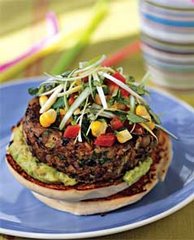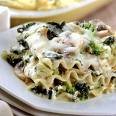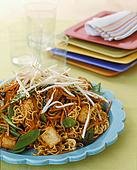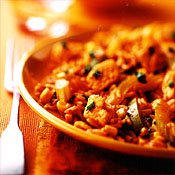My seven year old is a vegetarian. When she started her quest of avoiding meat we thought just cutting out meat itself would be enough, but it has become a journey of shocking, jaw-dropping discovery at just what contains ground-up animal parts. As a result, I am now a veggie. So I have gone from researching good recipes and nutritional information, which is essential for such a young vegetarian, to the family taking on a healthier, more compassionate outlook on life.
Wednesday, 11 April 2007
I think i'll go nude....
There are many clothing and household products derived from animals. Of course I am aware of things like wool and cashmere, what I wasn't aware of, however, is the inhumane way the animals are treated or the fact that, instead of shearing the lambs, many are just slaughtered, make you think twice about that pure new wool cardigan?
Alpaca
This fibre - it's a hair rather than a wool - comes from the alpaca, a relative of the llama, domesticated in the Andes for over 6000 years.
Angora
Angora is a fibre obtained from a special breed of rabbit. China and South America provide the bulk of the trade, which amounts to 4000 tonnes a year. The rabbits are not killed for their wool, but sheared regularly. Each rabbit will give between 200g and 1500g of wool a year. However, they are kept in cages in much the same way as rabbits bred for meat, and as they have a longer commercial life than meat rabbits, their suffering might be said to be even worse. Males have only about 75% of the wool yield of females, so are often routinely killed at birth.
Cashmere
Genuine Cashmere must be one of the most expensive fibres there is. It comes from the underbelly of a special breed of Himalayan goat (it's the animal's natural protection from the severe cold) and it is obtained by combing each goat by hand during the moulting season. One goat yields only about 4oz of cashmere per year and on average, it takes the yield of three goats to make one sweater. Of the world's cashmere 85-90% comes from China.
Down & Feathers
Many duvets are filled with down, the very soft feathers from the breasts of geese and ducks. Chickens and turkeys don't produce down. Down can be obtained by plucking, but over 90% is a slaughterhouse by-product, and even the birds that have been plucked end up on the table soon afterwards. Most down is produced in the Orient, Canada and Europe.
Beauty Without Cruelty charity reports (summer 1992) that in Hungary, France, Israel and China, live geese have their feathers ripped off, a process that may be repeated every 8 weeks for about 3 sessions until the bird is killed for food or force fed to make pate de foie gras.
The female eider duck plucks down from her breast to line her nest, after the chicks have grown up and abandoned the nest, the down can be collected by anyone brave enough to face the climb up the cliffs! A pound of eider down sells for 300 dollars so it's not easy to find items made from down collected in this way.
Ostriches are farmed for meat, leather, eggs and feathers. In 1982 South African farms produced 741,000lbs of feathers worth 2 million pounds (figures from Turning Point, Aug 91). The feathers are plucked from breeding birds every nine months or so. A British producer describes how birds are immobilised in a wooden V shaped crush, while feathers are cut off. The quills are left behind to die and fall out. In the wild, ostriches live for about 75 years; ostriches farmed for meat, leather and feathers are slaughtered at 12-14 months and so enjoy just a fraction of their normal lifespan. Their natural habitat is the open plains of Africa where they can run at speeds of up to 40mph. Farmed ostriches are kept in pens of quarter to half an acre per pair and in America, may be kept in truly intensive conditions, i.e. indoors.
Felt
Felt is a material produced by a process that mats and hardens the fibres. Felt is usually made from wool, but it can be made from fur. You should be careful buying a felt hat as it may be either. Rabbit skin is often the source of fur for felt hats.
Lanolin
Produced from sheep's wool. Used to make vitamin D3.
Mohair
This is the product of the white Angora goat. It's a long fibre, coarser than cashmere. Very large herds of up to 20,000 Angora goats are kept in South Africa and Texas, purely for mohair production.
Photography
All Photographic film uses gelatine (remember the ground up pork skins?)
Silk
Silk comes from silkworms, which are not true worms but the caterpillars of the silk moth, Bombyx mori. The caterpillars will only eat mulberry leaves and when they are ready to pupate, they protect themselves by spinning the silk round and round themselves to form a cocoon. Typically, each worm produces a mile and a half of continuous thread. When metamorphosis is complete and the moth is ready to leave its cocoon, it secretes an alkali which eats its way through the thread. This spoils the thread for spinning as it is no longer continuous. So, in order to get good quality silk, the moths must be killed before they leave the cocoon. This is done by suffocation with steam or heating them in an oven. Only a small number necessary for breeding the next generation are allowed to complete their lifecycle. Whether or not the pupae feel any pain whilst being suffocated or subjected to heat is debatable, but most vegetarians consider silk is not acceptable as it cannot be produced without the death of a living creature.
Wool
In Britain at least, wool production is just a by-product of the meat industry, as British wool doesn't command a high enough price to make it worth keeping sheep for their fleece alone. The sheep have to be sheared because the fleece gets so heavy and thick, they would suffer from heat-stroke during the summer if it were left on. However, this isn't a natural condition. Wild species of sheep survive without shearing. Through generations of selective breeding humans have changed the characteristics of the fleece to suit themselves, not the sheep. British wool tends to be used for coarse fabrics like carpets. The fine wool needed for good sweaters etc comes from Merino sheep, a breed that originated in Spain but which is now kept in vast numbers in Australia. About 70% of the wool used for clothing comes from Australia, where the practice of mule-sing, where folds of skin under the sheep's tail are removed without an anaesthetic to form a wool free scar to discourage blow flies, is common. Approximately 27% of UK wool is skin wool, i.e. obtained from slaughtered sheep, mainly lambs.
Source: Vegetarian Society
I’m going to look at leather and fur another time, I think we have had enough cruelty for one day.
Alpaca
This fibre - it's a hair rather than a wool - comes from the alpaca, a relative of the llama, domesticated in the Andes for over 6000 years.
Angora
Angora is a fibre obtained from a special breed of rabbit. China and South America provide the bulk of the trade, which amounts to 4000 tonnes a year. The rabbits are not killed for their wool, but sheared regularly. Each rabbit will give between 200g and 1500g of wool a year. However, they are kept in cages in much the same way as rabbits bred for meat, and as they have a longer commercial life than meat rabbits, their suffering might be said to be even worse. Males have only about 75% of the wool yield of females, so are often routinely killed at birth.
Cashmere
Genuine Cashmere must be one of the most expensive fibres there is. It comes from the underbelly of a special breed of Himalayan goat (it's the animal's natural protection from the severe cold) and it is obtained by combing each goat by hand during the moulting season. One goat yields only about 4oz of cashmere per year and on average, it takes the yield of three goats to make one sweater. Of the world's cashmere 85-90% comes from China.
Down & Feathers
Many duvets are filled with down, the very soft feathers from the breasts of geese and ducks. Chickens and turkeys don't produce down. Down can be obtained by plucking, but over 90% is a slaughterhouse by-product, and even the birds that have been plucked end up on the table soon afterwards. Most down is produced in the Orient, Canada and Europe.
Beauty Without Cruelty charity reports (summer 1992) that in Hungary, France, Israel and China, live geese have their feathers ripped off, a process that may be repeated every 8 weeks for about 3 sessions until the bird is killed for food or force fed to make pate de foie gras.
The female eider duck plucks down from her breast to line her nest, after the chicks have grown up and abandoned the nest, the down can be collected by anyone brave enough to face the climb up the cliffs! A pound of eider down sells for 300 dollars so it's not easy to find items made from down collected in this way.
Ostriches are farmed for meat, leather, eggs and feathers. In 1982 South African farms produced 741,000lbs of feathers worth 2 million pounds (figures from Turning Point, Aug 91). The feathers are plucked from breeding birds every nine months or so. A British producer describes how birds are immobilised in a wooden V shaped crush, while feathers are cut off. The quills are left behind to die and fall out. In the wild, ostriches live for about 75 years; ostriches farmed for meat, leather and feathers are slaughtered at 12-14 months and so enjoy just a fraction of their normal lifespan. Their natural habitat is the open plains of Africa where they can run at speeds of up to 40mph. Farmed ostriches are kept in pens of quarter to half an acre per pair and in America, may be kept in truly intensive conditions, i.e. indoors.
Felt
Felt is a material produced by a process that mats and hardens the fibres. Felt is usually made from wool, but it can be made from fur. You should be careful buying a felt hat as it may be either. Rabbit skin is often the source of fur for felt hats.
Lanolin
Produced from sheep's wool. Used to make vitamin D3.
Mohair
This is the product of the white Angora goat. It's a long fibre, coarser than cashmere. Very large herds of up to 20,000 Angora goats are kept in South Africa and Texas, purely for mohair production.
Photography
All Photographic film uses gelatine (remember the ground up pork skins?)
Silk
Silk comes from silkworms, which are not true worms but the caterpillars of the silk moth, Bombyx mori. The caterpillars will only eat mulberry leaves and when they are ready to pupate, they protect themselves by spinning the silk round and round themselves to form a cocoon. Typically, each worm produces a mile and a half of continuous thread. When metamorphosis is complete and the moth is ready to leave its cocoon, it secretes an alkali which eats its way through the thread. This spoils the thread for spinning as it is no longer continuous. So, in order to get good quality silk, the moths must be killed before they leave the cocoon. This is done by suffocation with steam or heating them in an oven. Only a small number necessary for breeding the next generation are allowed to complete their lifecycle. Whether or not the pupae feel any pain whilst being suffocated or subjected to heat is debatable, but most vegetarians consider silk is not acceptable as it cannot be produced without the death of a living creature.
Wool
In Britain at least, wool production is just a by-product of the meat industry, as British wool doesn't command a high enough price to make it worth keeping sheep for their fleece alone. The sheep have to be sheared because the fleece gets so heavy and thick, they would suffer from heat-stroke during the summer if it were left on. However, this isn't a natural condition. Wild species of sheep survive without shearing. Through generations of selective breeding humans have changed the characteristics of the fleece to suit themselves, not the sheep. British wool tends to be used for coarse fabrics like carpets. The fine wool needed for good sweaters etc comes from Merino sheep, a breed that originated in Spain but which is now kept in vast numbers in Australia. About 70% of the wool used for clothing comes from Australia, where the practice of mule-sing, where folds of skin under the sheep's tail are removed without an anaesthetic to form a wool free scar to discourage blow flies, is common. Approximately 27% of UK wool is skin wool, i.e. obtained from slaughtered sheep, mainly lambs.
Source: Vegetarian Society
I’m going to look at leather and fur another time, I think we have had enough cruelty for one day.
Subscribe to:
Post Comments (Atom)
































No comments:
Post a Comment